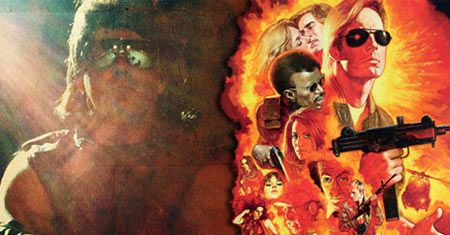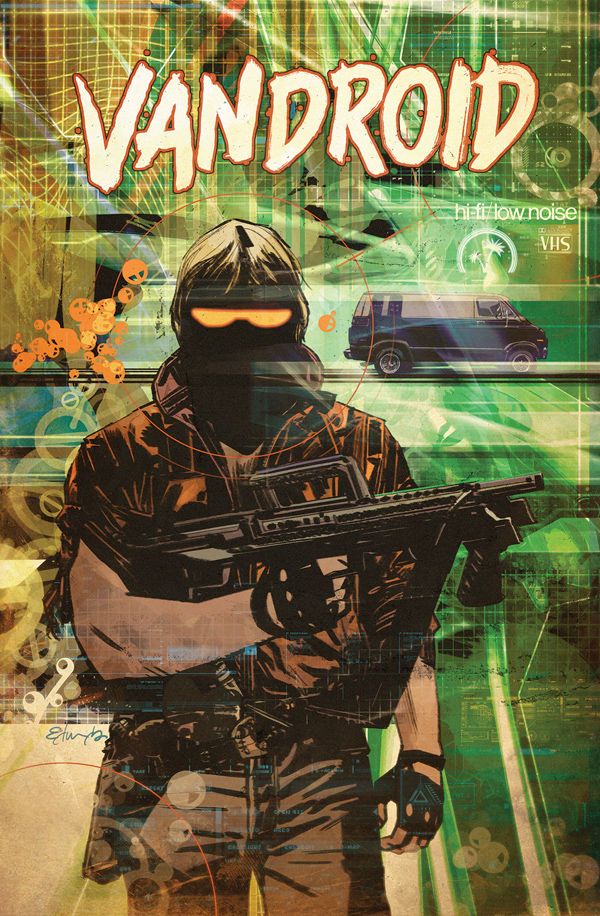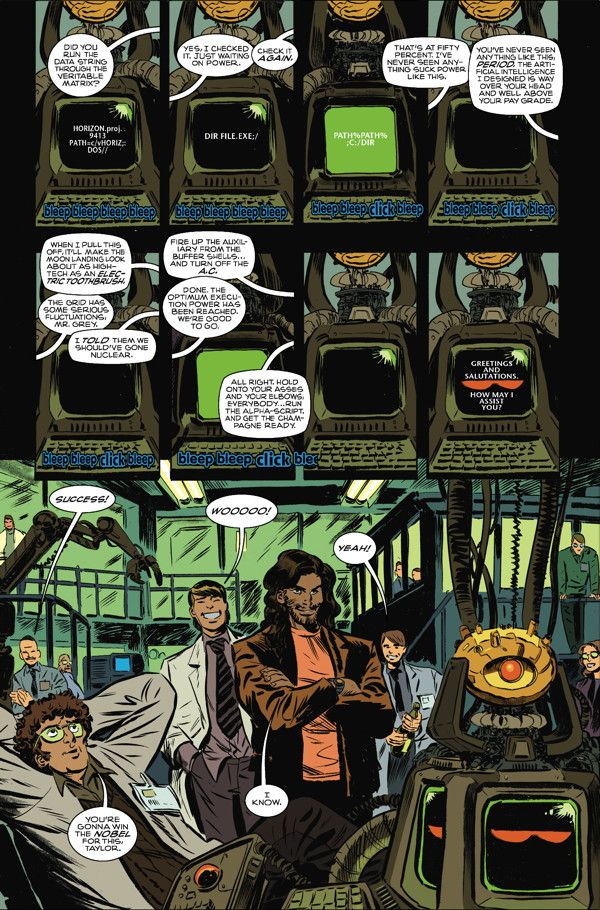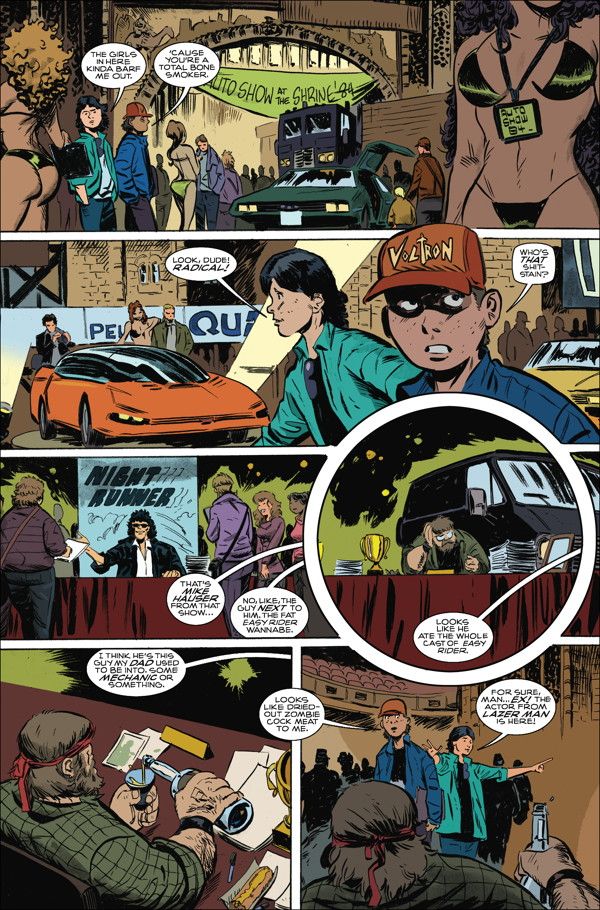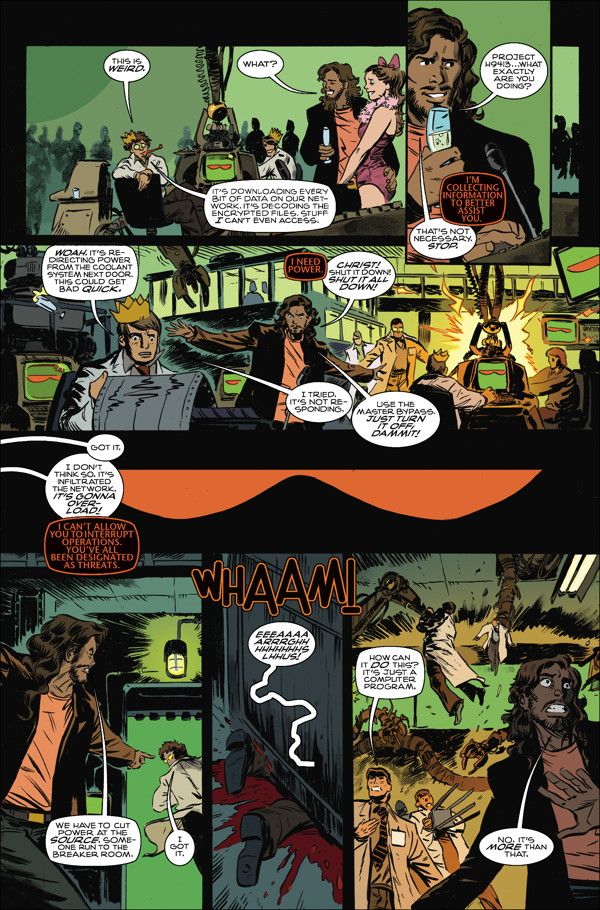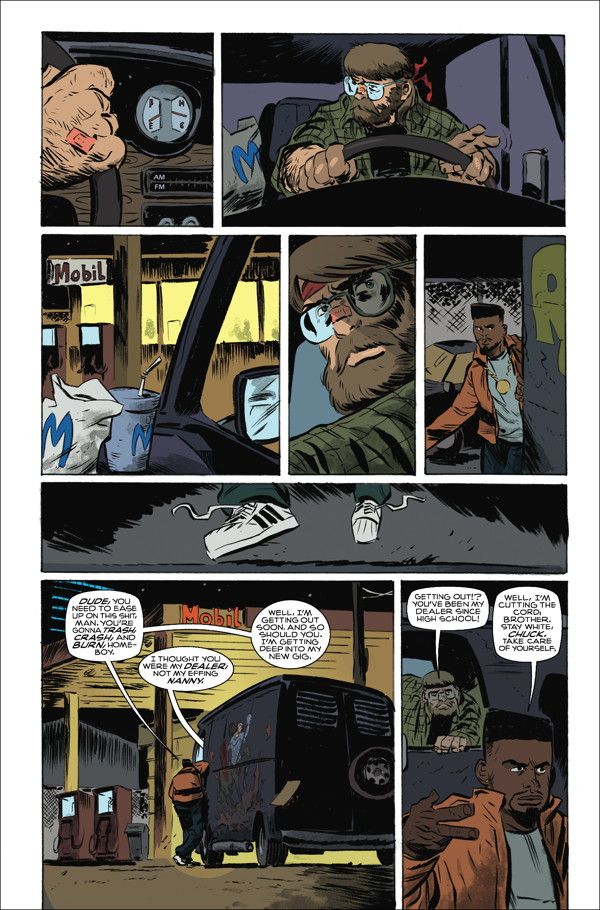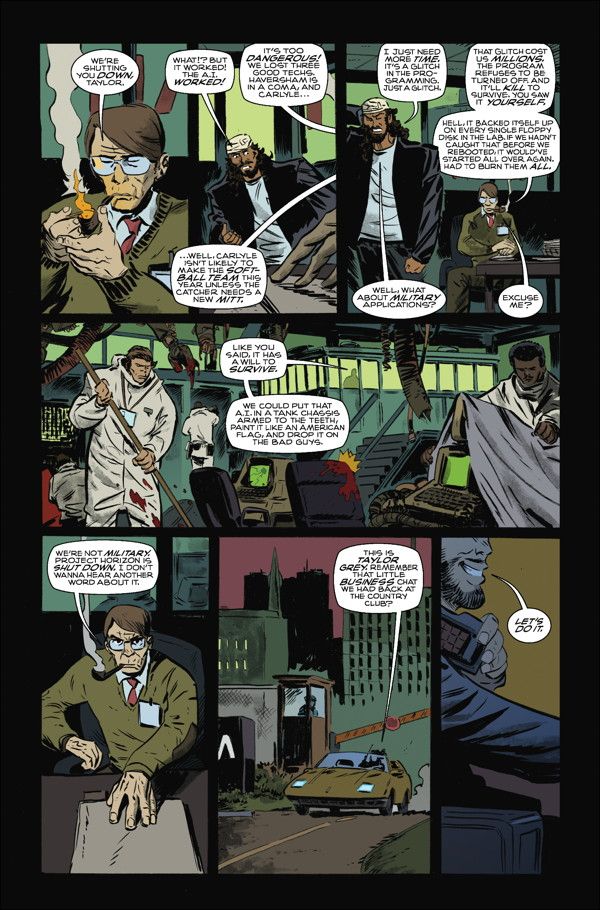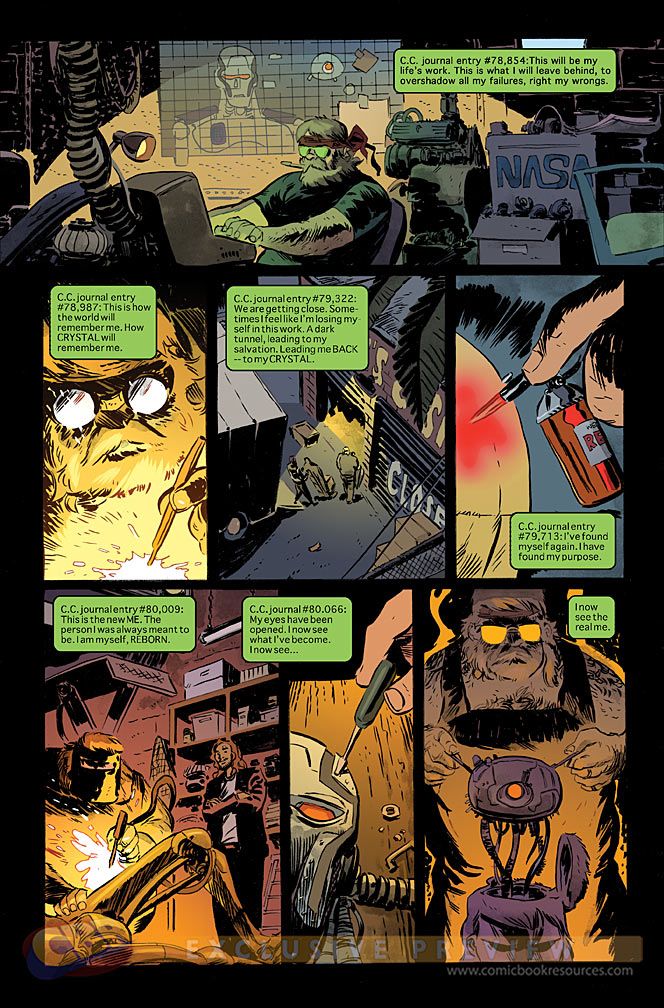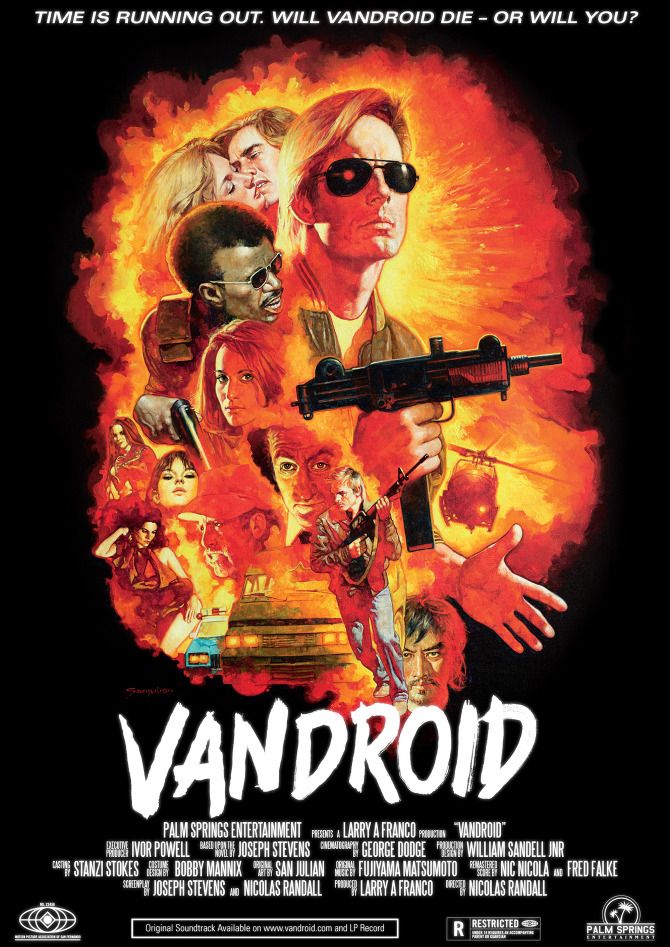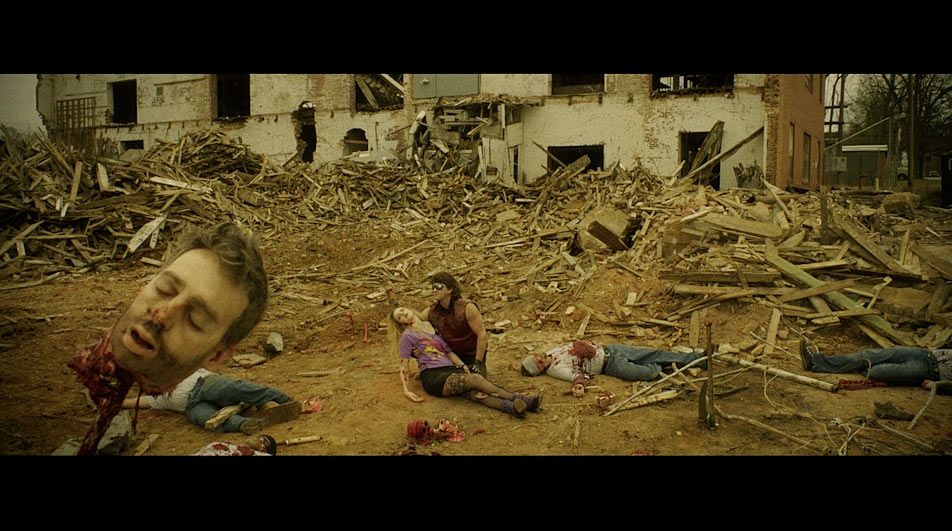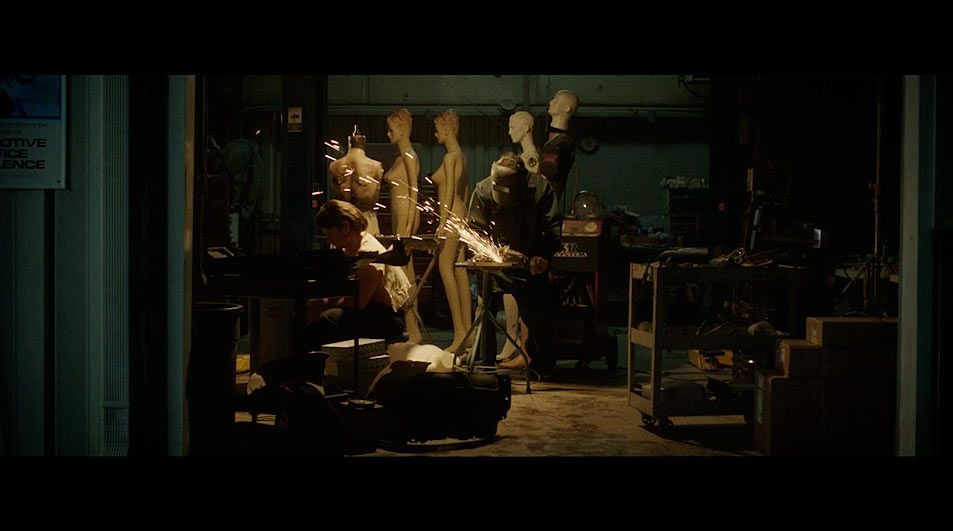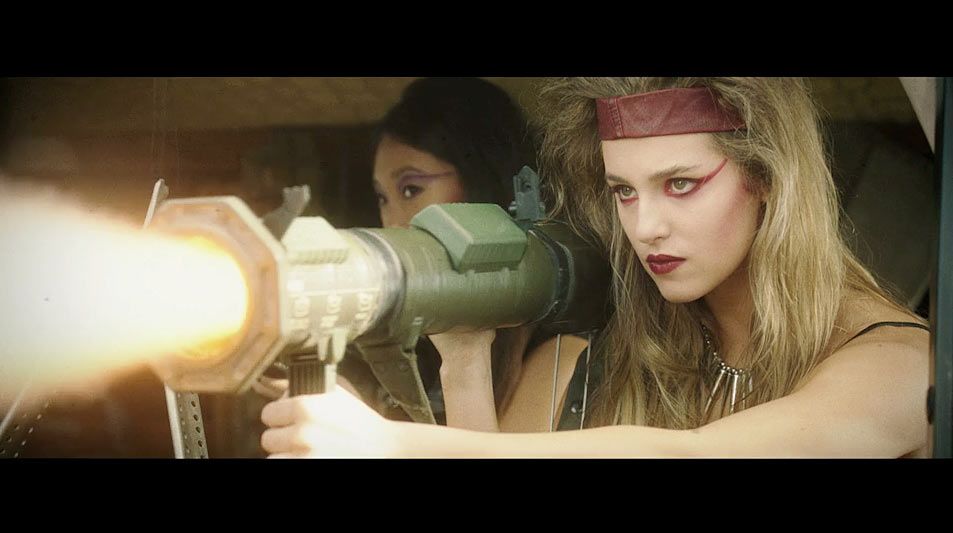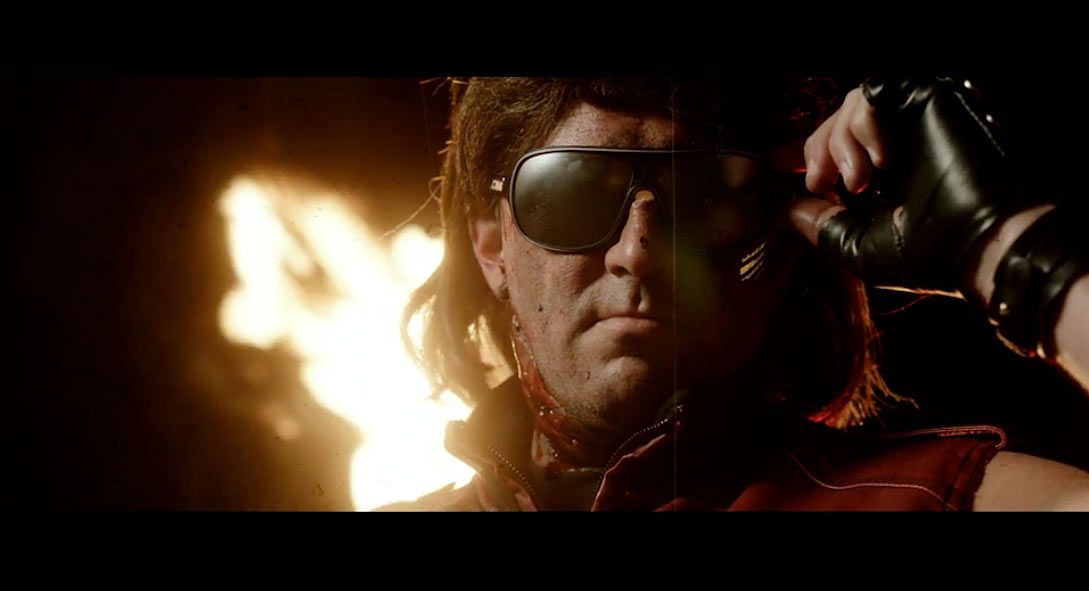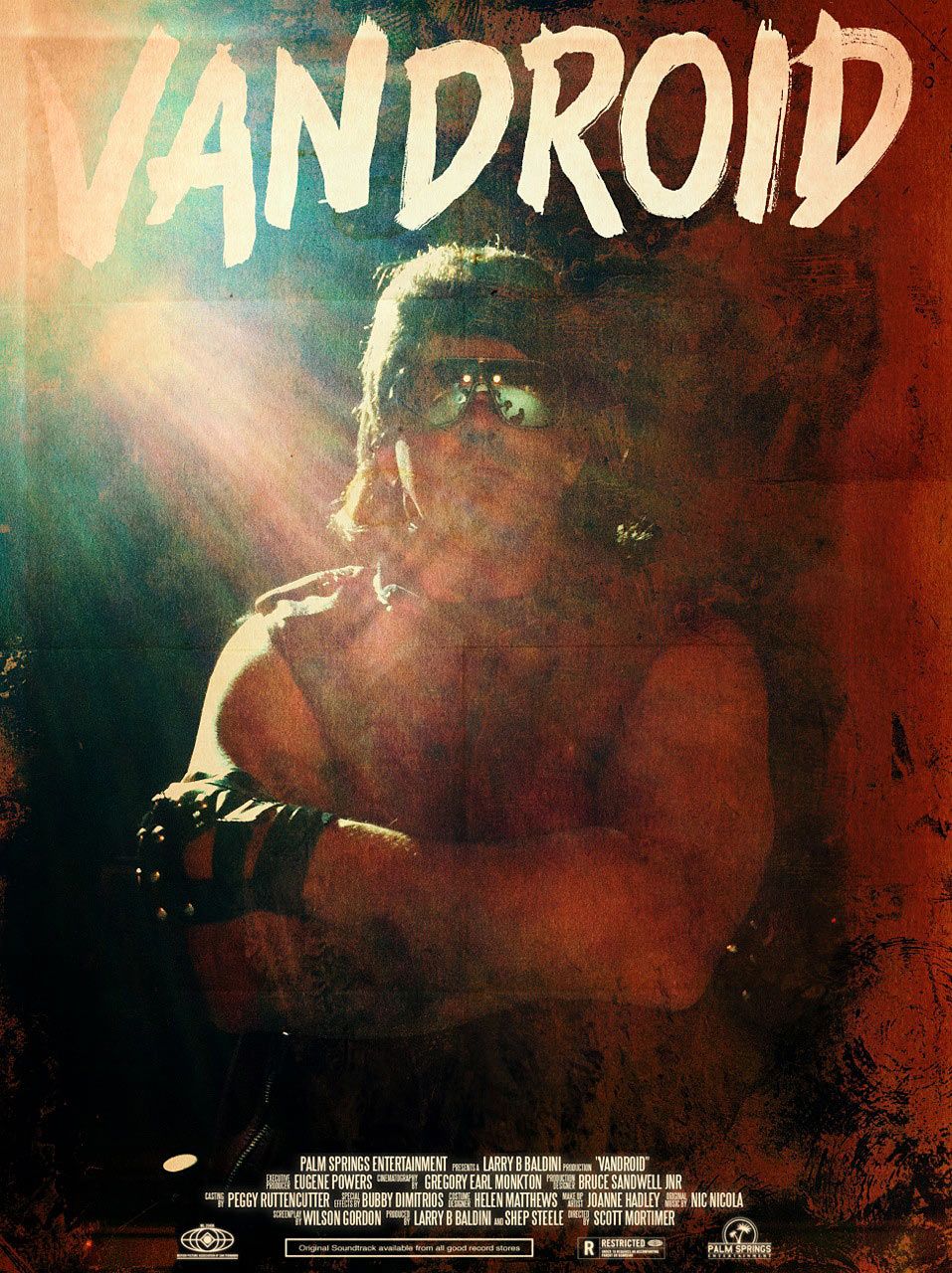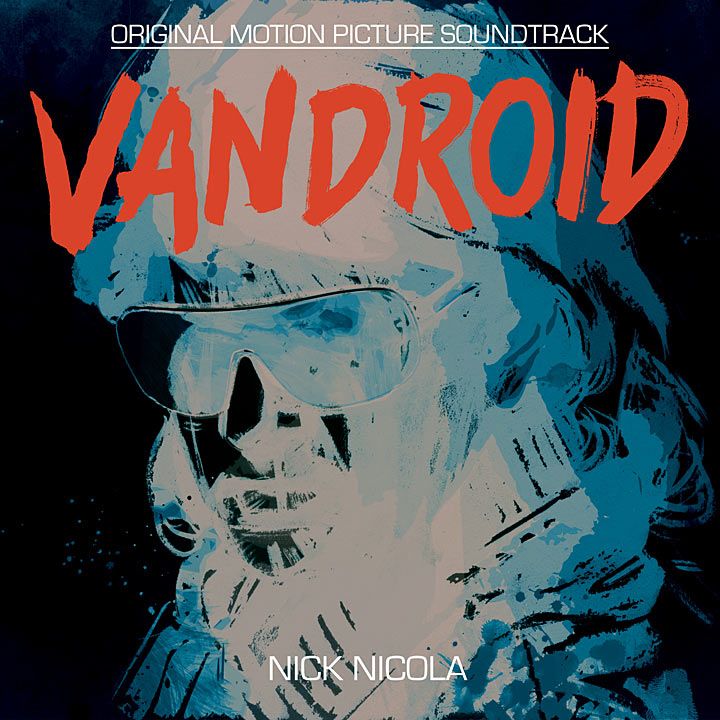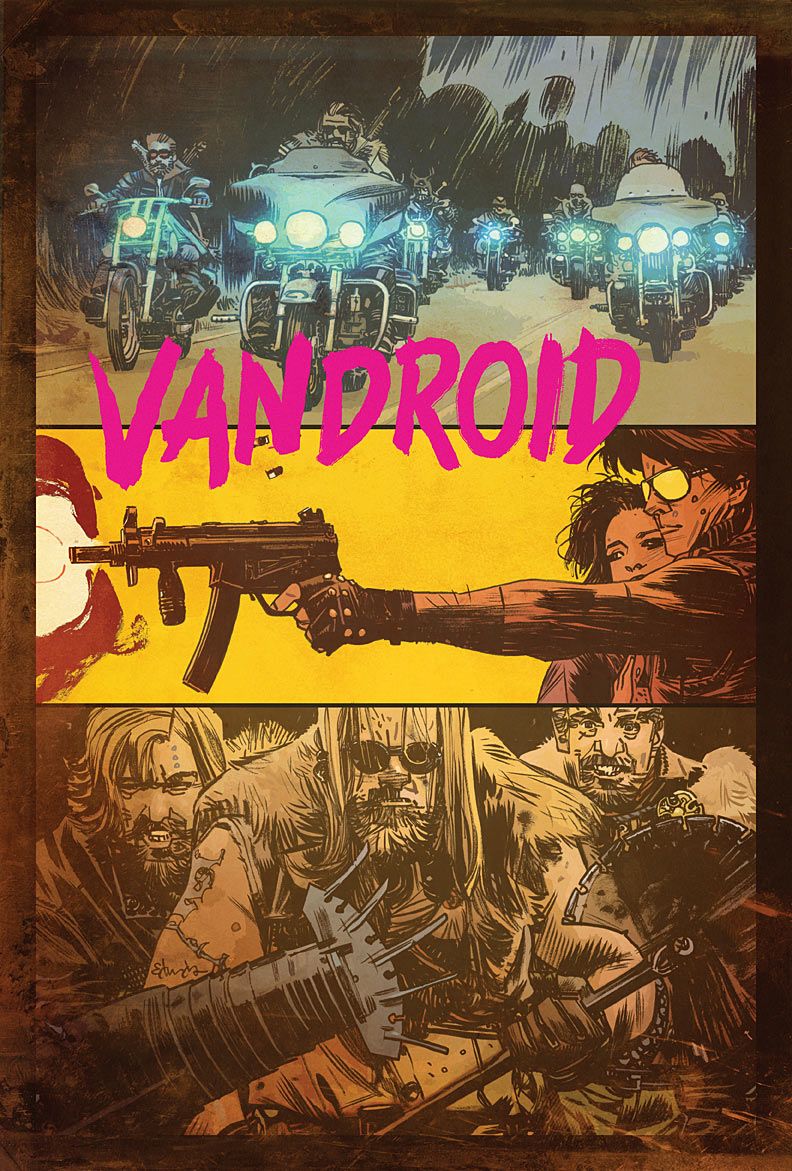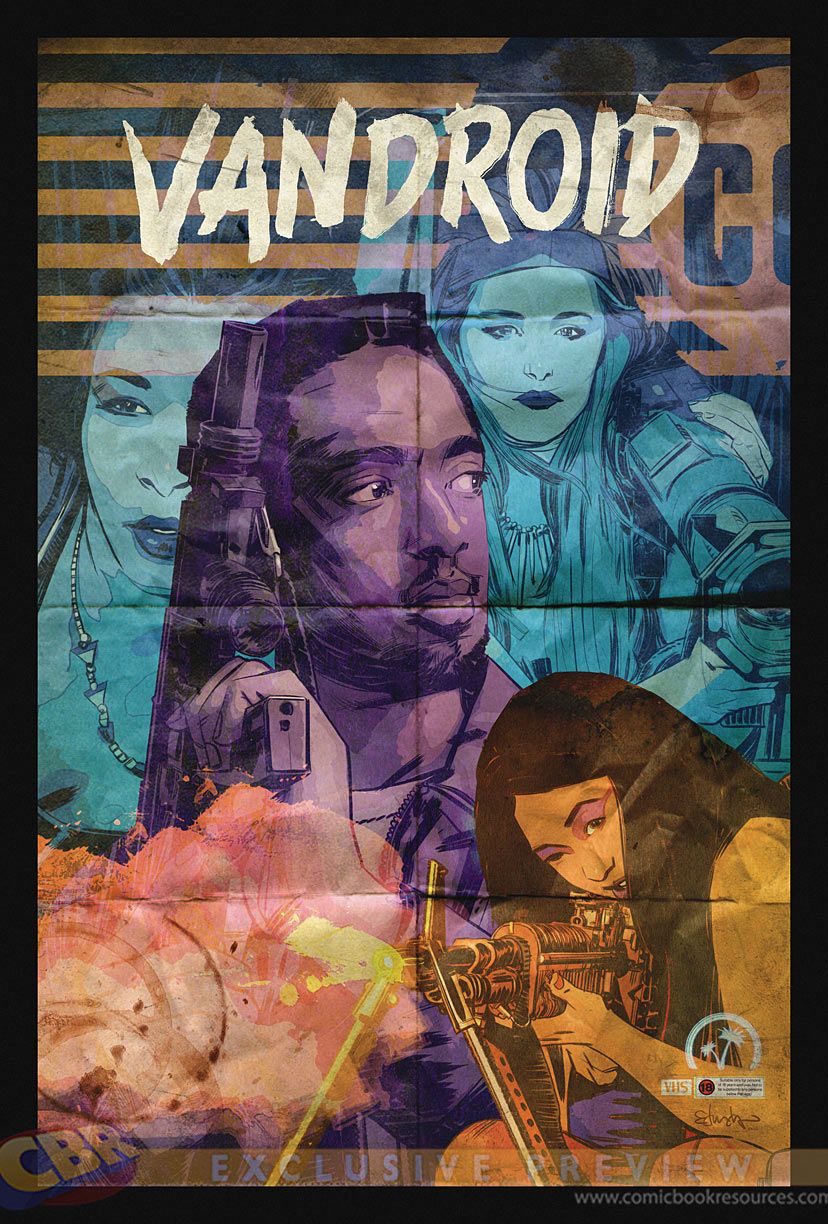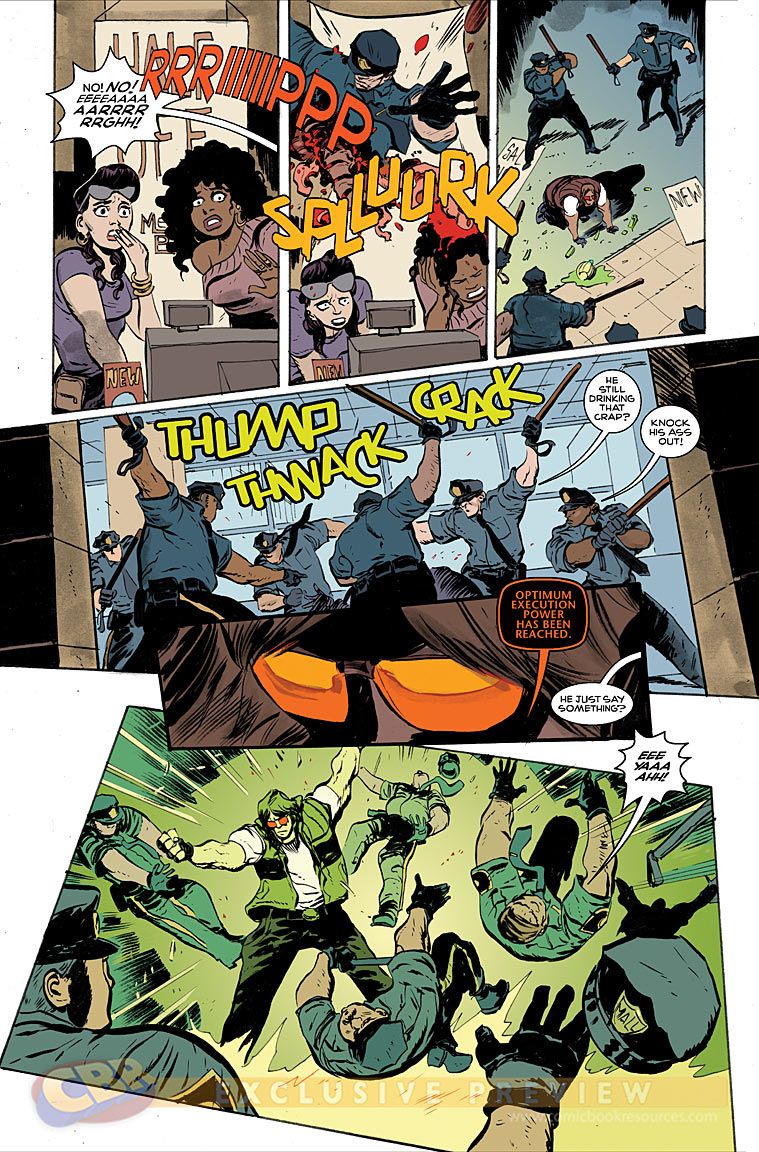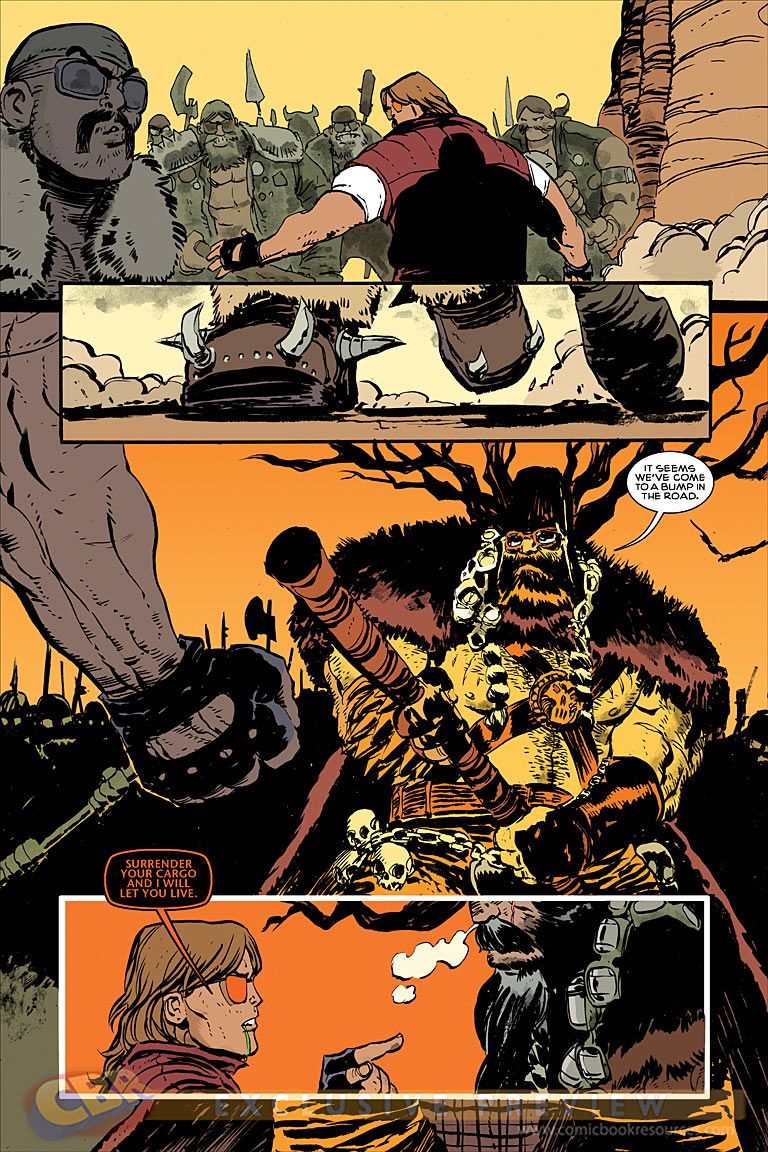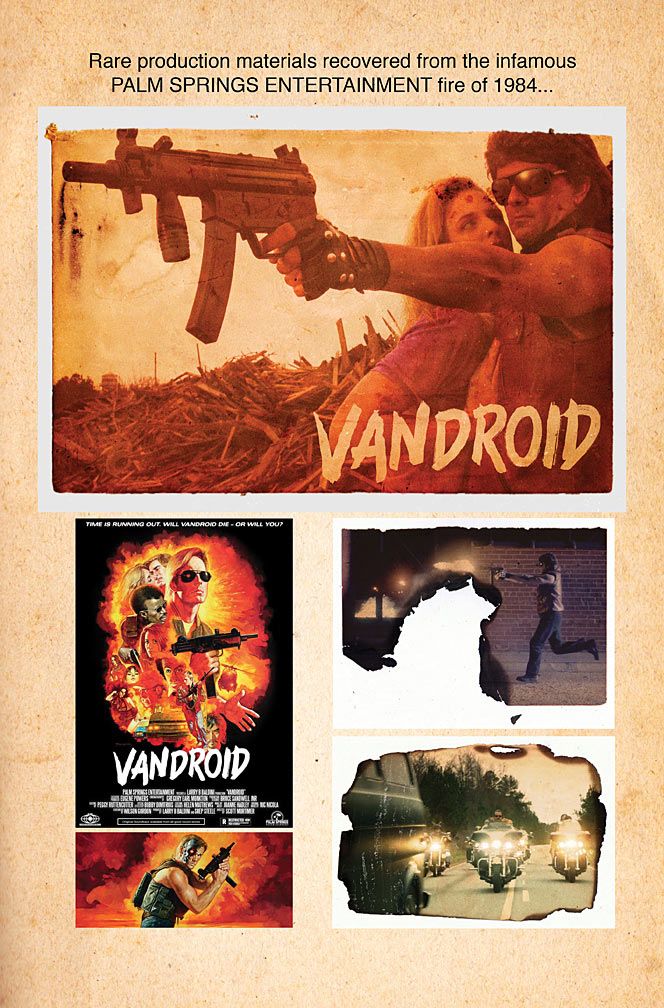I'm listening to the fictional soundtrack of a fictional "lost" 1984 movie called "Vandroid." The title says it all. Androids, greasy machismo -- one part "Terminator," one part "Cobra," "Vandroid" is everything you remember about '80s action sci-fi flicks. Mullets, cut-off denim vests, exploitation. And, if the fictional trailer was anything to go by, "Vandroid" was destined for box office gold. Unfortunately, the studio producing the flick was ripped apart by an uncontrollable fire. And like so many good things, "Vandroid" was gone before its full potential was realized.
Luckily enough, the screenplay and a few promotional items survived, just enough material for Tommy Lee Edwards and his motley crew of pros to capture that same grindhouse strut into a new Dark Horse Comics miniseries beginning Feb. 26. Edwards couldn't revive the forgotten film on his own, and in addition to co-writing and providing covers he pulled in co-writer Noah Smith, artist Dan McDaid and colorist Melissa Edwards. All four creators spoke to CBR News about how they're pulling off one of the greatest comic book revivals in fake cinema history.
valnetvalnet
CBR News: Tommy, for the uninitiated, what's "Vandroid" about?
Tommy Lee Edwards:"Vandroid" is an action-adventure sci-fi story loaded with lots of wit. It's very silly, fun, exciting, and tragic. The story centers on a genius rockstar mechanic named ChuckCarducci, who made his name as one of the top mechanics of the mid-1970s custom vanning craze. His artistic and award-winning designs were seen across the world. Then came the money, the women, and the drugs. Carducci was on top of the world. But by 1984, when our story takes place, vanning is all but dead. Chuck is now a major has-been who's fallen into a spiral of drug-induced depression, and is manipulated by an old roommate from his MIT days to team up on a new project using cutting edge (and extremely dangerous) artificial intelligence.
With salvaged electronics from NASA's Jet Propulsion Lab, high-performance van parts and a Plutonium Ion battery dubiously procured by a mysterious financial backer, Chuck builds the robot in his own ideal likeness. Not only is Vandroid built as a visual reflection of Chuck's glory days, his A.I. brain's processor and memory banks are filled with every positive aspect of Chuck's life. Chuck basically puts everything he ever wished he was into Vandroid, and the robot now has a chance to fulfill his creator's lost potential.
Throughout the series, Vandroid finds his place in the world by turning against the very militarized corporate devils who helped create him. While stacking up dead enemy bodies and uncovering a ridiculous conspiracy, Vandroid ends up rekindling the fire of Chuck's broken marriage, builds a squad of lethal companions called The Vanettes andteams up with Chuck's best childhood friend to rain down plenty of fiery vengeance.
NYCC: Tommy Lee Edwards Drives "Vandroid" to Dark Horse
Where did the idea come from, to coalesce the different media into one package?
Tommy Lee Edwards:The whole thing started with Nick Nicola's music. Nic introduced me to his "Vandroid" soundtrack a couple years ago, along with the backstory about the '80s action movie that never was. I immediately fell in love with it. I wanted to build upon the whole idea of Vandroid's untold story. Just as Nic's music gives me warm nostalgic fuzzies in my tummy,the thought of Vandroid as a comic "movie adaptation" from that era really made me feel like an excited kid again. Fast forward through about a year of development, and now we've got the imminent release of the comic from Dark Horse and the album from legendary French electronic label Ed Banger. Tying it all together is the "Vandroid" movie. The "lost classic." We've released a 30-second teaser. Soon will be the unveiling of a music video and the extended 4.5 minute extended trailer.
Noah, as the co-writer, where do you find your strengths lie? Is this your first jump into comics?
Noah Smith: This is my first foray into writing for comics, though I've been a big reader since I was a kid. "Vandroid" has been a lot of fun and the comic format in general is really interesting. I hope to do more in the future.
I've come from a screenwriting background and so I'm used to conceptualizing stories visually, but Tommy's resume in that area is incredible. I've been very lucky to have someone introduce me to the form that knows firsthand what an illustrator needs from a script.
I think some of my strengths I've discovered on this book are in the dialogue and comedic character moments.Some of my favorite pages could have been tedious exposition, but end up being a lot of fun due to the comic banter.The villains in this book are a lot of fun to write.
What tools and applications from screenwriting have you brought over to comic book scripting?
Noah Smith: There are certain mechanics of screenwriting that are pretty universal to storytelling and come in handy; but partly because I'm a movie fan and partly because the project calls for it, I have approached this project more like it is a film we are producing. I think of the story in terms of dramatic structure, plot twists, cliffhangers and plenty of snappy dialogue, but I'm also considering costumes, casting and location scouting. So when we write a big fight scene I think about how we can make it more than just another brawl. I think of these moments as opportunities for huge set pieces and crazy stunts. There's a term used amongst agents and producers, "Trailer Moments." What kind of outrageous action sequence or line delivery is going to make that trailer reel?
A nice thing is that on the page, budget is no issue. We can have a huge gunfight in a mall, massive explosions, costumed gangs.
Most of my screenwriting has been drama so this is a huge change of pace, but a welcome one. I'm unapologetically in love with this type of genre film.
So as I write, I just keep going back in my head to consider what kind of movie I want "Vandroid "to be. And it's a lot of fun.
What's the collaborative process like between the two of you?
Noah Smith: At first we just get together and hash out ideas on how to best translate the general source material.We turn that into an outline document and then we cut it up into to a page-by-page breakdown of the comic.These breakdowns are pretty brief, a paragraph or so of everything that happens for each page.From there we just divide up pages and go write them on our own.We usually have a sense of what scenes we feel like we'd be best at approaching.After we finish, we swap them back and forth and do a polish on each other's pages.Then we discuss any changes or issues we had and we're pretty much good to send it out to the rest of the creative team.
We're really having a lot of fun drawing on the audacity of the '80s action genre.
Tommy Lee Edwards: Looking for "true collaboration" is the primary reason I chose not to tackle "Vandroid" by myself, and instead put together the creative team you now see on the series. Along with Noah being a fantastic writer and producer for some of the film and animation work I've directed, we've been buddies for at least ten years. We like a lot of the same stuff, and spent much of our childhoods renting VHS movies based on how "bad ass" the box cover art was. Most of "Vandroid" was written by Noah and I sitting together at the kitchen on our MacBooks, laughing so hard that we can barely see or breathe. Working with friends is the best part of "Vandroid" for me. I haven't had that in comics for a long time, and really wanted "Vandroid" to be crazy fun for us creators, as well as the audience. It really celebrates the joy of comics in a way I haven't seen in a long time.I'm really proud of how entertaining "Vandroid" is, while maintaining a very well-structured story with some genuine surprises and character development mixed along with some retro archetypes and familiar themes.
Tommy & Melissa, what's your working relationship like?
Tommy Lee Edwards: Melissa and I met and became friends through our love of art. While I was studying illustration and film at Art Center in California, Melissa was studying art history at University of Michigan. We got married in 1995, while I was just starting out in mainstream comics. I had some horrific ink and color jobs over my early work. Throughout time, I built up a reputation of needing complete control over my comics, which meant making my own creative team or doing it all myself. Melissa used to color loads of my work, back when I did more comics. Early stuff like "Gemini Blood," "Moon Knight," "Legends of the Dark Night," " Zombie World," "Disavowed," and on and on.
She quickly became a highly requested colorist by other artists because she knew color theory, storytelling and could draw. So Melissa ended up coloring a lot of our friends' books. Guys like Mike McMahon, Toby Cypress, Lee Bermejo, and especially John Paul Leon. I think some of her best work was on JP's "Static Shock" and "Earth X" books.
Melissa Edwards: I haven't colored anything in a long time since I chose to concentrate on homeschooling our kids and running our home business instead.When the previous "Vandroid" colorist had to bow out, we thought it would be fun for me to step back in for a limited run and collaborate on this book. The actual day-to-day working relationship usually involves us sitting at opposite ends of the kitchen table, with me occasionally asking for an opinion on color. It's fun to bounce ideas back and forth to come up with the best palette for each scene.
That's cool. How did you decide upon the mood/the palette for the book?
Melissa Edwards: Well, I really choose the palettes for each scene based on the script, the art and what will serve the story best.This is my favorite part of coloring -- the broad palette ideas and color design.I try to leave my colors as just that -- a compliment to the art and story.I like to create moods and feelings rather than overpower a scene.
Let's talk about the art for the book. Dan, what I've seen so far looks rad -- a nice gritty '80s action vibe happening; like the movie "Black Rain" meets "Mad Max." Can you tell me a bit about the style you're employing for the book?
Dan McDaid: I'm never consciously thinking about the movies you mention -- or any movies, particularly -- but all this stuff is hard-wired into my generation, so it's definitely coming through. I could quote all of "The Terminator" at you, and I bet that's true of almost every male my age. So yeah -- Ridley Scott, James Cameron, George Miller, all those guys who effectively invented the '80s, all of that is making its way into the pages. Them and Grace Jones. It's hard to put my finger on, but this thing totally has a Grace Jones thing going on, you know? Maybe 'cause it's slightly ridiculous but also completely earnest? And it's about robots, and the '80s... and '80s robots.


As for my approach to the art -- it's a mixture of stuff, really whatever feels right on the day. A bit of Euro comics, a bit of Frank Miller, a bit of Chaykin. I'm not consciously trying to ape any one particular influence, but it's hard not to do an extended '80s riff without hearkening back to Miller and Chaykin a bit. But my emphasis is on movement, texture, big solid chunks of black. Something nice and meaty for the reader to get their teeth into. If I can get people saying "this looks rad" then I've definitely done my job.
Who else are your influences, and what's your work process like?
Dan McDaid: The influences one is a little tricky, because my stock answer is usually "Kirby," but there isn't much Kirby in this to speak of. For this one, there's a bit of early Simonson creeping in, a bit of manga, a bit of... jeez, everything, really. Whatever my mood is like on the day goes straight into the page. There's an extended action sequence across the end of issue #2 and into #3 that has kind of a [Philippe] Druillet vibe, I guess. But none of it's intentional, and it's all down to mood and what serves the story best.
"Vandroid" is not a comic, it's not a motion picture, it's not a soundtrack -- it's an experience, isn't it?
Tommy Lee Edwards:In a similar fashion to the way I made "Brandon Generator" with Edgar Wright for Microsoft, I'm working with a team of friends to create a whole experience that combines many of our favorite mediums. Although each medium delivers perfectly well on its own, the whole project is meant to be enjoyed on many different levels. It's all in the service of telling Vandroid's story in the best possible ways.
"Vandroid" #1 drives into stores Feb. 26!

